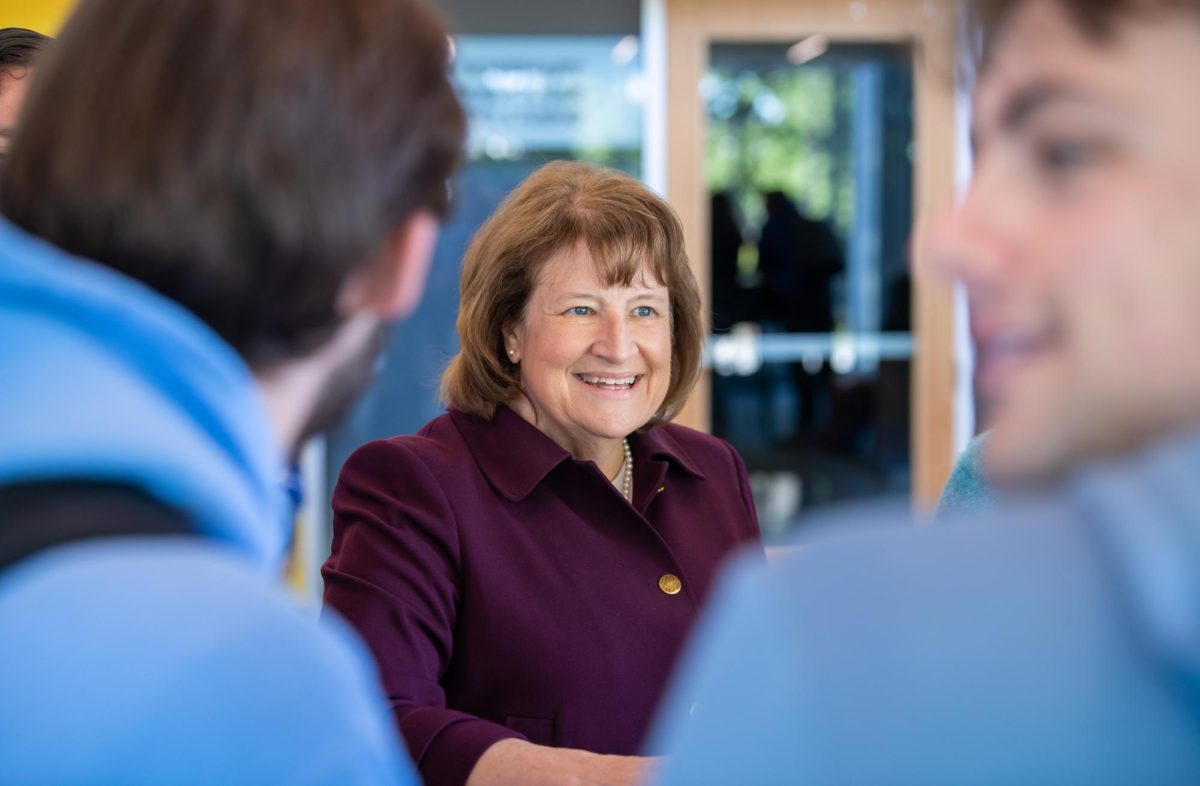“To be just, is not enough to refrain from injustice. One must go further and refuse to play its game, substituting love for self-interest as the driving force of society,” said Father Pedro Arrupe, Superior General of the Jesuits from 1965-1983.
As listeners gathered in the Arrupe Auditorium on the evening of Feb. 29, Rockhurst welcomed Professor Adam Rothman, Visiting Scholar Lecture Series speaker presenting on “Slavery, Memory and Reconciliation at Jesuit Universities.”
As a professor at Georgetown University in Washington D.C., Rothman felt called to “share this story” as the beginning of Jesuit reconciliation with history. Before beginning his lecture, Rothman offered recognition to Father Pedro Arrupe and his calling to the Jesuits to seek justice in the world. After reminding the audience of the Rockhurst Core Value of Reflection and Discernment, he dove into the three pillars of his presentation: history, memory and reconciliation.
History
Georgetown, the oldest Jesuit university in the United States established in 1789, has a deep entanglement with American slavery. For many people, it is thought that slavery is something that happened long ago and far away. For the Georgetown community, however, it is something that happened not long ago, and right where they are.
At the end of the 1600s, Jesuits were some of the most prominent landowners, and by the end of the 1700s, Jesuits were some of the most prominent slave owners. Several of Georgetown’s first students would bring their slaves to the school in exchange for paying their university fees. With slaves living, working and dying at the school, the “campus itself was a sight of slave labor” according to Rothman.
He brings to light that the university’s affair with slavery “was never a secret; it was never hidden away,” but rather, there was a lack of knowledge and investigation.
Georgetown was connected to a series of Jesuit-owned plantations across the country, a common tie between Jesuit universities and plantations where they shared slaves and other resources with one another. It was a group of Georgetown Jesuits who brought their slaves to Missouri to build and found Saint Louis University.
Rothman shared the story of one enslaved man named Isaac Hawkings. Hawkings worked at and belonged to Georgetown University, and one day he tried to escape in attempt to free himself. Georgetown, however, chased him down and exhibited the true “dedication of the school to return their human property.” Isaac was not the only slave who tried to escape. He was one of many who fell victim to the university’s harsh slave labor fight.
Eventually, a “Catholic slave-holding ethic” arose, as some believers wanted to support a transition to freedom. However, others wanted money for their enslaved people before moving forward. In 1838 the Maryland Jesuits, to whom Georgetown was a part of, sold their slaves to Louisiana to financially support the university, which is commonly referred to as the GU272+. Up until 1862, the slave-holding network remained, financially benefiting Jesuits.
As they recognize their injustices of the past, the university named a building after Hawkings and has documented their history with slavery in its Georgetown Slavery Archive. Rothman declares it is “not enough to rename a building or build a monument.” The archive is an ongoing initiative that continues to research and uncover its jarring past.
Despite these efforts, for Georgetown, “history still lingers in our very identity as a school” visible through its university colors of blue and grey: the colors of the confederate uniforms.
Memory and Reconciliation
Since Georgetown has started to shed light to its past, other schools have followed. Brown University, Harvard University, University of Virginia and Glasgow University have all started to examine their own histories and relationships with slavery.
During these last two pillars of the lecture, Rothman invited viewers to learn about the Descendants Truth and Reconciliation Foundation. He calls the Descendants Truth and Reconciliation Foundation a “first-of-its-kind initiative between the descendants of the enslaved and the descendants of the enslavers.”
The organization hopes to lead by example, seeking to help heal a deep and important wound, to “mitigate the dehumanizing impact of racism on our human family while dismantling the continuing legacy of slavery in America through truth, racial healing and transformation.”
Rothman defined the meaning of repair and reconciliation as a “reflective engagement.” He shared Georgetown’s ongoing pursuits of justice, including the taking of general university funds and relocating them towards a GU272+ reconciliation fund.
The $400,000 Reconciliation Fund was launched as a commitment to benefit descendants of the 314 enslaved people whom the Maryland Jesuits sold in 1838. Further, the university invites and hopes to learn and hear from descendants of the GU272+.
Although the Georgetown University is taking steps toward reconciliation, Rothman reminds viewers that we are “only at the very beginning.” Rockhurst too, as a Jesuit university, should reflect on the past and recognize areas where injustice was present and try to make reconciliation.
Rockhurst University invites students and the community to join them on April 18 at 7:30 pm in Arrupe Auditorium for its final 2024 Visiting Scholar Lecture Series presenter, Arielle Johnson, Ph.D., speaking on “Everything You Need to Know About Flavor (But Never Knew to Ask!).”








